ManageEngine ServiceDesk Plus
LAST UPDATED: AUG 15, 2025
Overview
ManageEngine ServiceDesk Plus is a comprehensive help desk and asset management software used to maintain an organization's assets and IT requests.
D3 SOAR is providing REST operations to function with ManageEngine ServiceDesk Plus.
ManageEngine ServiceDesk Plus is available for use in:
Known Limitations
ManageEngine ServiceDesk Plus enforces API rate limits, though currently, specific thresholds are not publicly documented. To maintain reliable operation, consider limiting API calls to under 30 requests per minute across all endpoints as a conservative best practice.
Connection
To connect to ManageEngine ServiceDesk Plus from D3 vSOC, follow this part to collect the required information below:
Parameter | Description | Example |
Server URL (domain level) | The ManageEngine ServiceDesk Plus Cloud Data Center Domain API URL. Users can check their API Server URL at Multiple Data centres - REST API - User Guide. | https://sdpondemand.manageengine.com |
Authentication Redirect URL | The redirection URL for the Zoho Application Client. | https://*****/VSOC/Auth2Callback.aspx |
Client ID | The application client ID obtained from the Zoho API Console used to authenticate the connection. | **** |
Client Secret | The application client secret obtained from the Zoho API Console used to authenticate the connection. | **** |
Authentication Code | The authorization code used to authenticate the connection. Click the Get Authorization button on the Connection form to automatically generate the authorization code. | **** |
Refresh Token | The refresh token used to authenticate the connection. Click the Get Refresh Token button on the Connection form to automatically generate a refresh token. | **** |
API Version | The version of the API used for the connection. | v3 |
Permission Requirements
To run all commands, the ALL request scope has been hardcoded for this integration. See OAuth 2.0 - API - User Guide for more information about the ALL request scope.
Configuring ManageEngine ServiceDesk Plus to Work with D3 SOAR
Determine which Server URL to use for the connection by visiting Multiple Data centres - REST API - User Guide. Refer to step 3i, sub-step 1 in Configuring D3 SOAR to Work with ManageEngine ServiceDesk Plus.
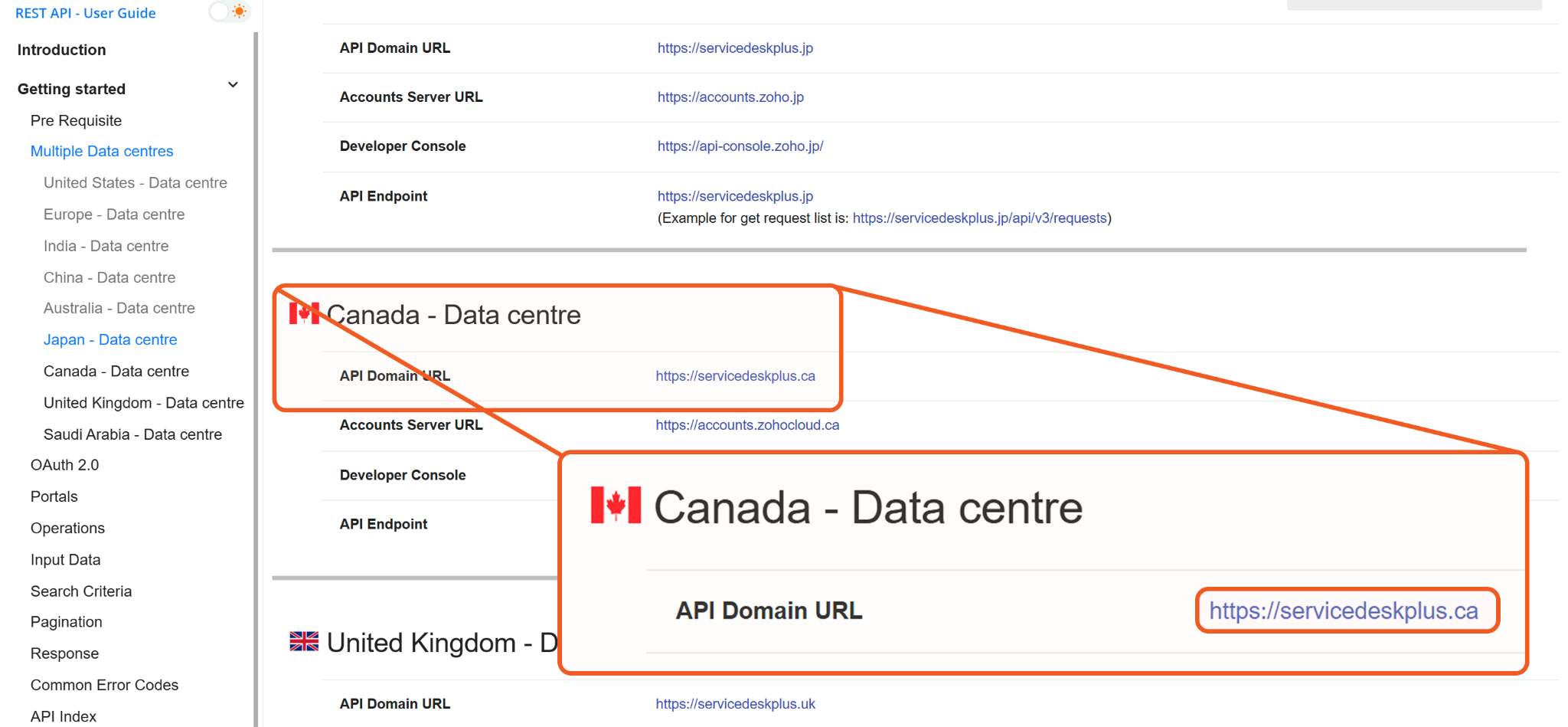
For example, if an organization’s instance is hosted in the Canadian data center, the corresponding Canadian API Domain URL must be used for the Server URL (i.e., https://servicedeskplus.ca).
Log in to the Zoho API Console.
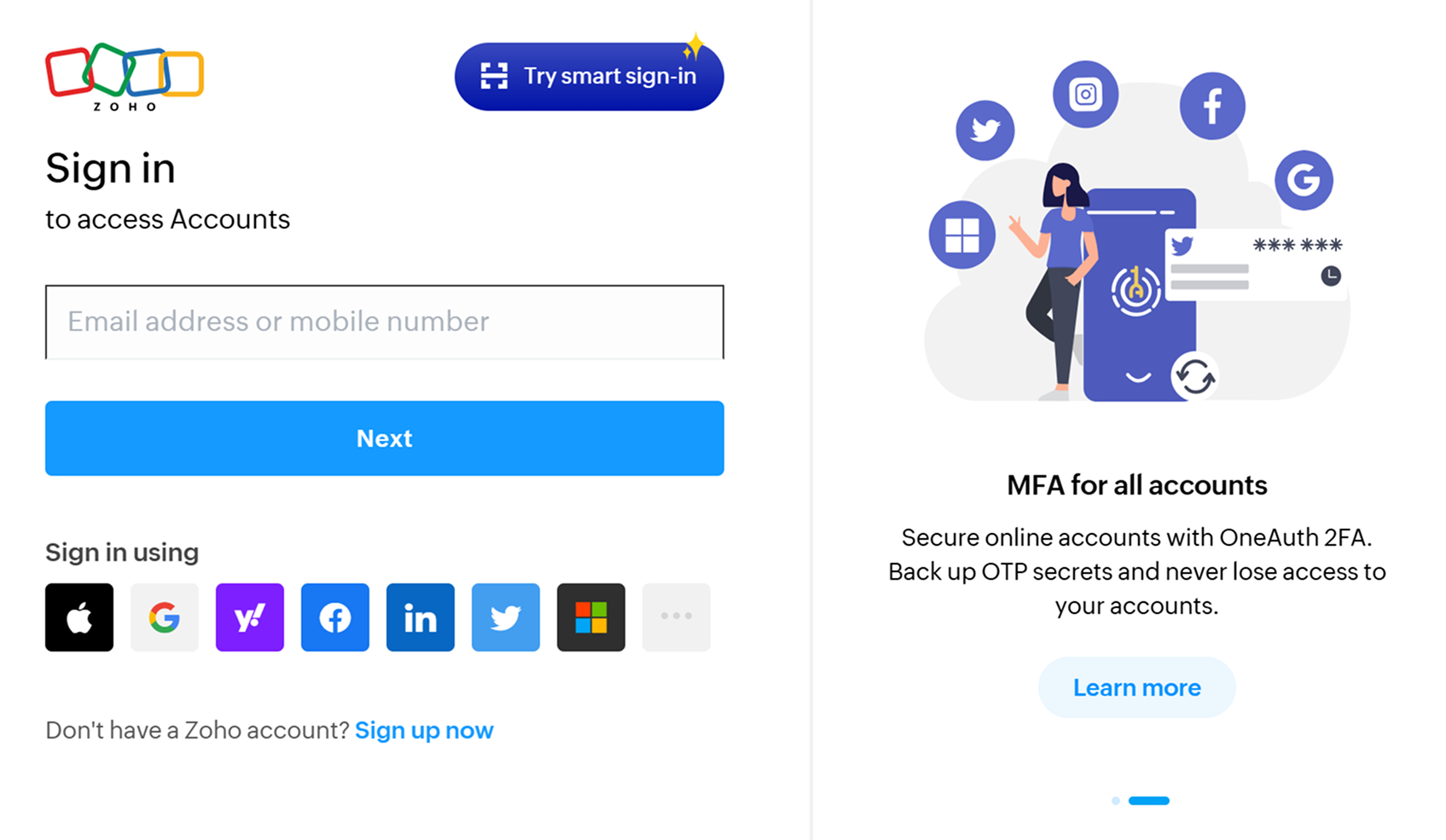
Similar to the API Domain URL, the API Console URL varies by region. Users are automatically redirected to the API Console URL for their respective region.
Click on the + Add Client button.
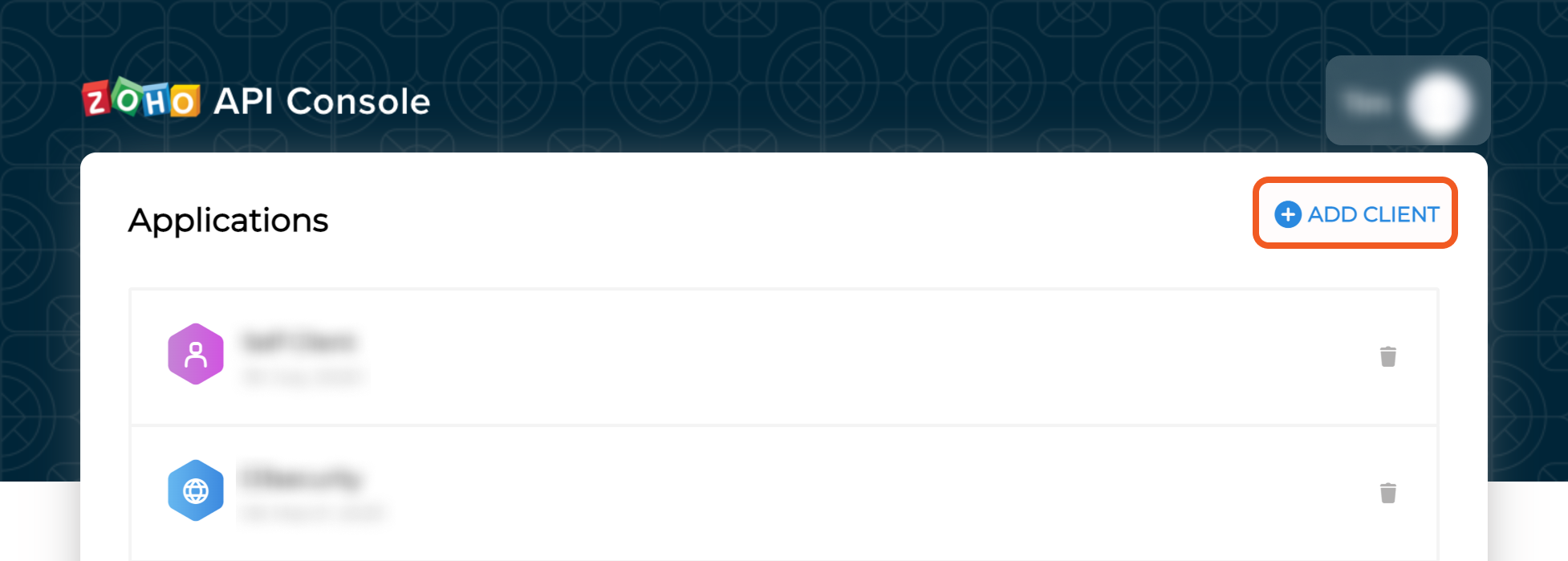
Select Server-Based Applications.
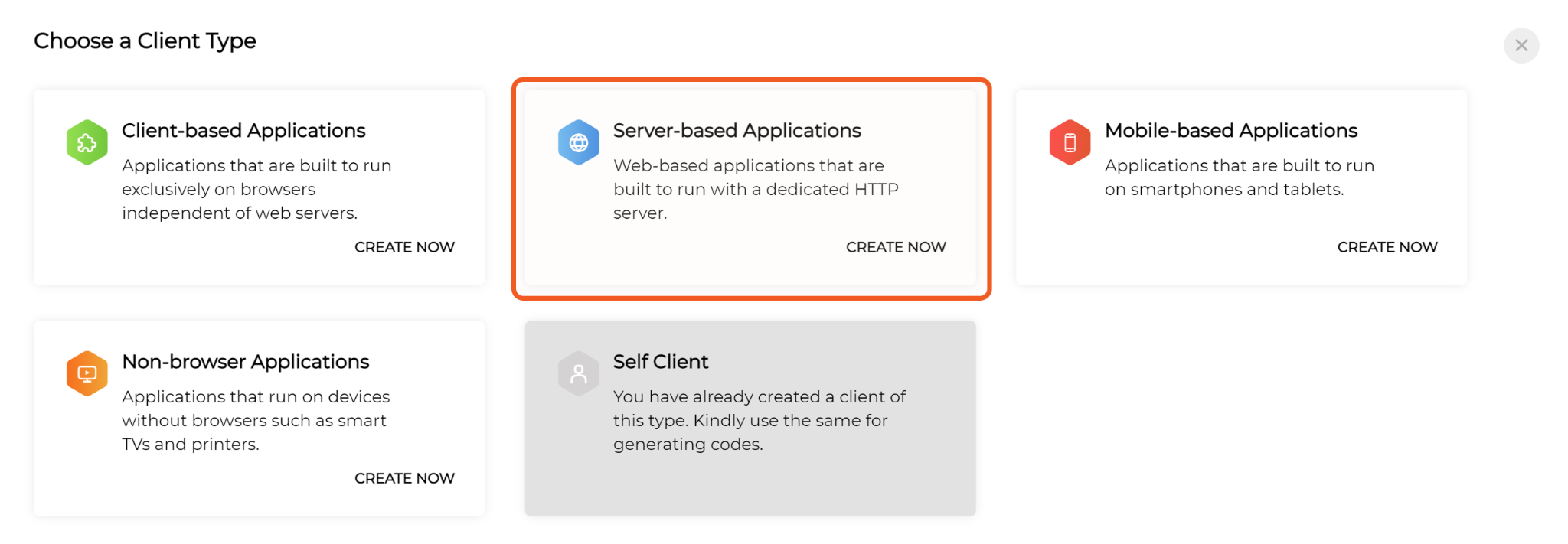
Enter the application name in the Client Name field and the vSOC URL in the Homepage URL field.
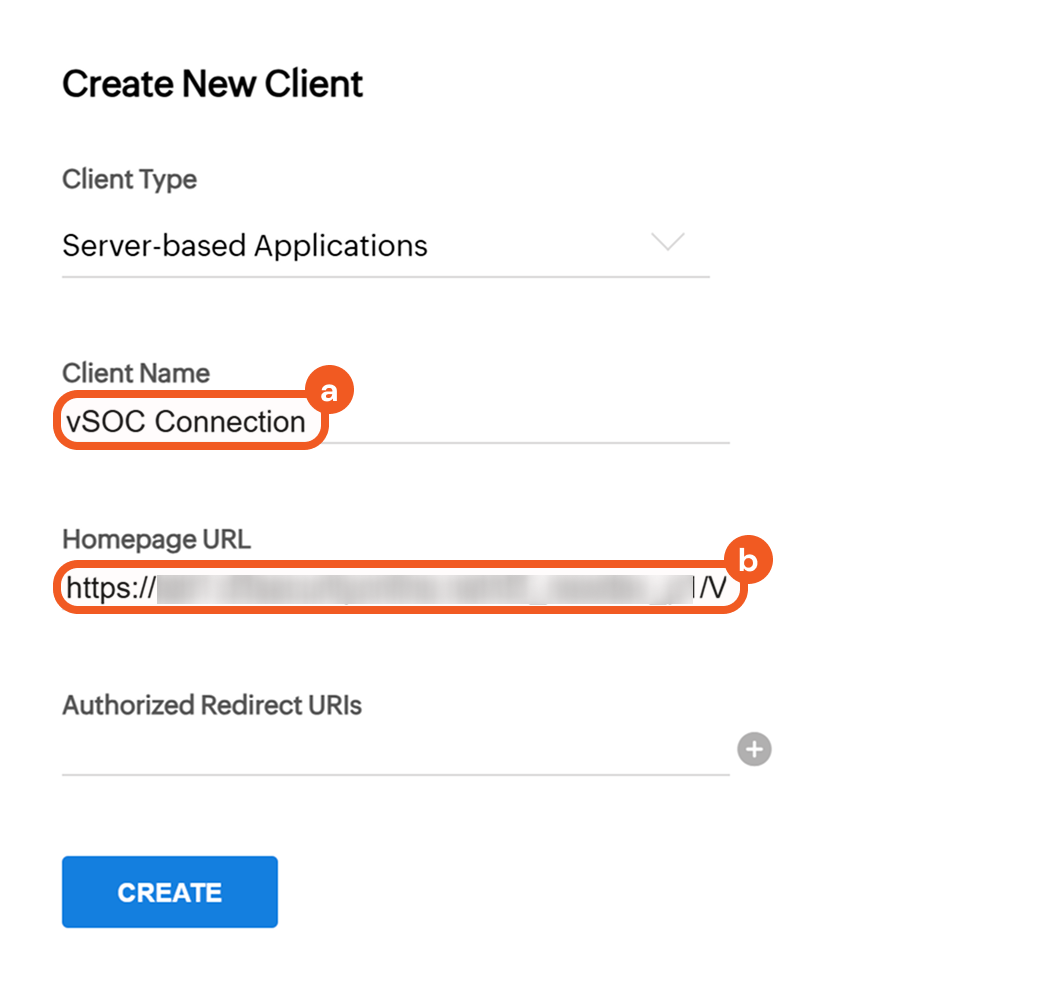
Input the Authentication Redirect URL from the D3 vSOC platform into the API Console, then click on the Create button. Refer to step 3i, sub-step 2 in the Configuring D3 SOAR to Work with ManageEngine ServiceDesk Plus.
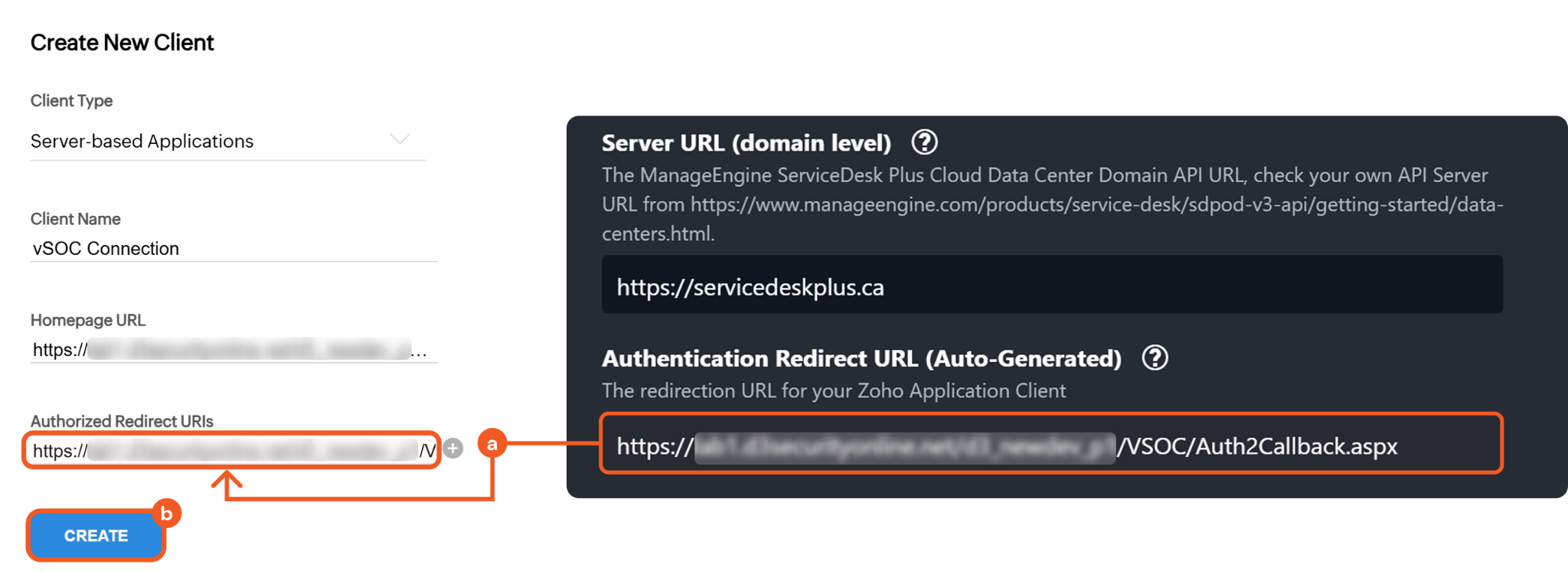
Copy and securely store the Client ID and Client Secret for later use. Refer to step 3i, sub-steps 3 and 4 in the Configuring D3 SOAR to Work with ManageEngine ServiceDesk Plus.
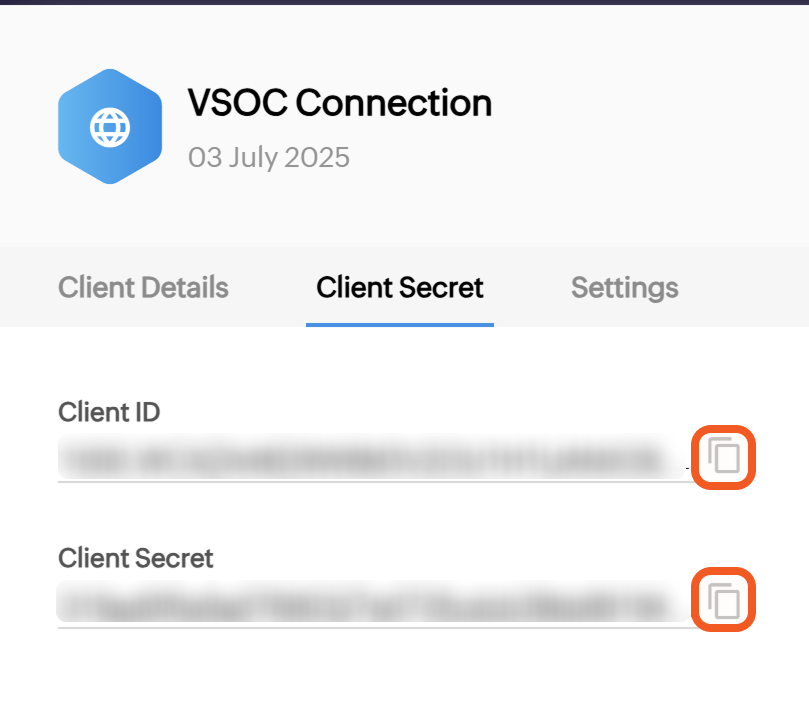
Click the Settings tab, then select the Use the same OAuth Credentials for all data centers checkboxes and enable all data center card toggles.
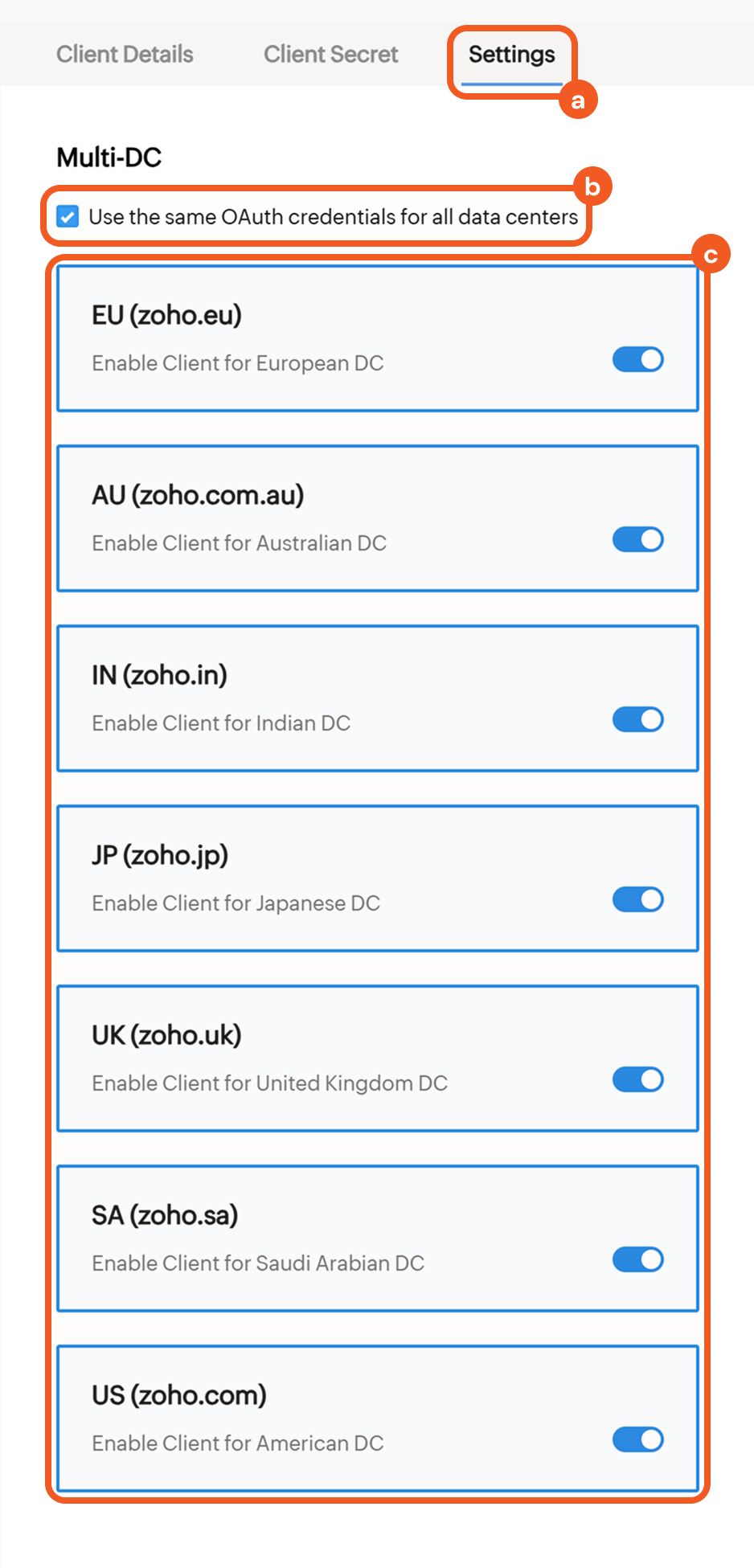
Configuring D3 SOAR to Work with ManageEngine ServiceDesk Plus
Log in to D3 SOAR.
Find the ManageEngine ServiceDesk Plus integration.

Navigate to Configuration on the top header menu.
Click on the Integration icon on the left sidebar.
Type ManageEngine ServiceDesk Plus in the search box to find the integration, then click it to select it.
Click + Connection, on the right side of the Connections section. A new connection window will appear.
Configure the following fields to create a connection to ManageEngine ServiceDesk Plus.
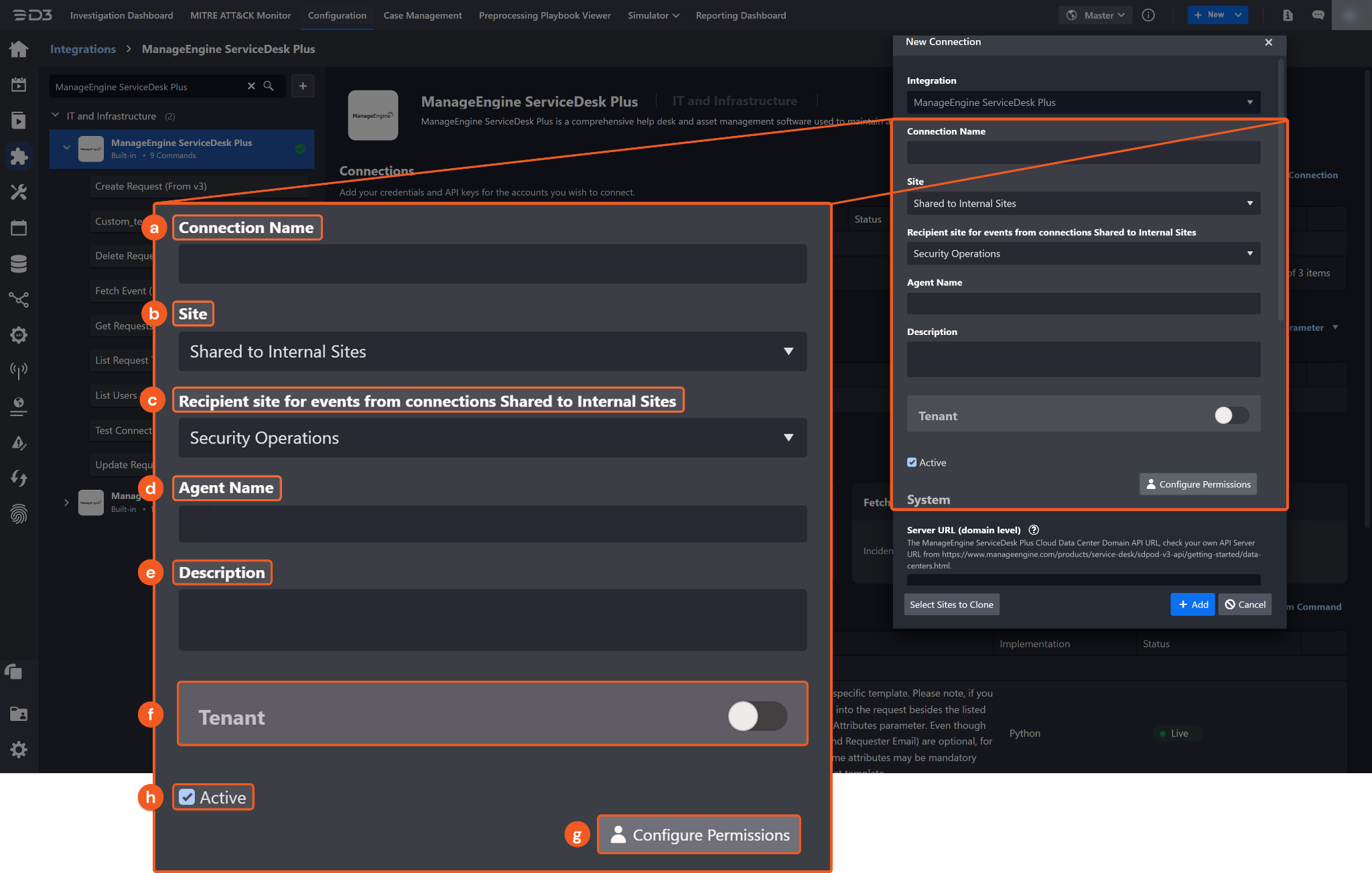
Connection Name: The desired name for the connection.
Site: Specifies the site to use the integration connection. Use the drop-down menu to select the site. The Share to Internal Sites option enables all sites defined as internal sites to use the connection. Selecting a specific site will only enable that site to use the connection.
Recipient site for events from connections Shared to Internal Sites: This field is displayed when Share to Internal Sites is selected for the Site field, allowing selection of the internal site for deploying the integration connection.
Agent Name (Optional): Specifies the proxy agent required to build the connection. Use the dropdown menu to select the proxy agent from a list of previously configured proxy agents.
Description (Optional): Add a description for the connection.
Tenant (Optional): When configuring the connection from a master tenant site, users have the option to choose the specific tenant sites to share the connection with. Once this setting is enabled, users can filter and select the desired tenant sites from the dropdowns to share the connection.
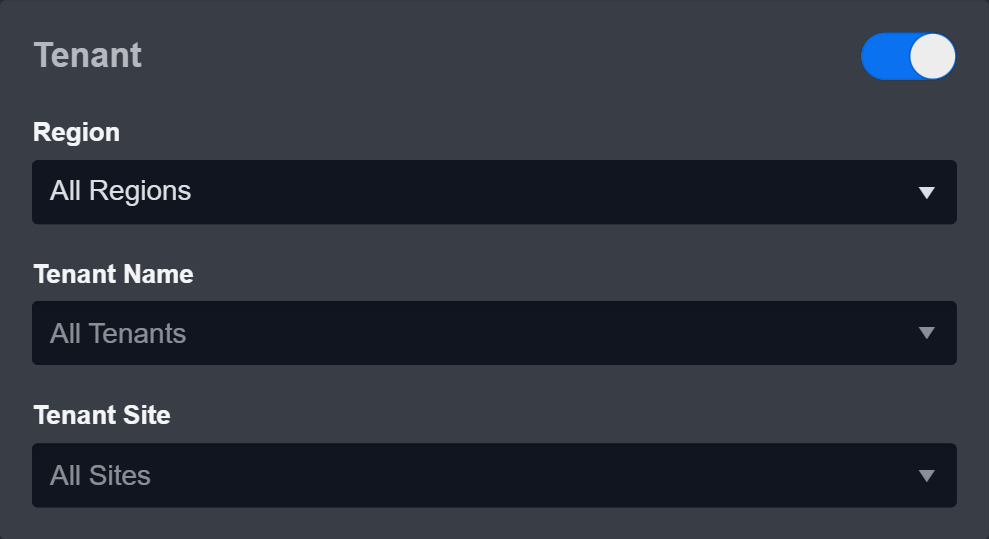
Configure User Permissions: Defines which users have access to the connection.
Active: Check the checkbox to ensure the connection is available for use.
System: This section contains the parameters defined specifically for the integration. These parameters must be configured to create the integration connection.
.png?inst-v=18d3a7e1-e76a-4a76-8c99-1863ec3d3efa)
1. Input the domain level Server URL. Refer to step 1 in Configuring ManageEngine ServiceDesk Plus to Work with D3 SOAR.
2. Copy the Authentication Redirect URL and paste it into the Authorized Redirect URIs field on the Zoho API Console. Refer to step 6 in Configuring ManageEngine ServiceDesk Plus to Work with D3 SOAR.
3. Input the Client ID. Refer to step 7 in Configuring ManageEngine ServiceDesk Plus to Work with D3 SOAR.
4. Input the Client Secret. Refer to step 7 in Configuring ManageEngine ServiceDesk Plus to Work with D3 SOAR.
5. Click on the Get Authentication button.
Log in upon redirection and click the Accept button to grant access permissions.
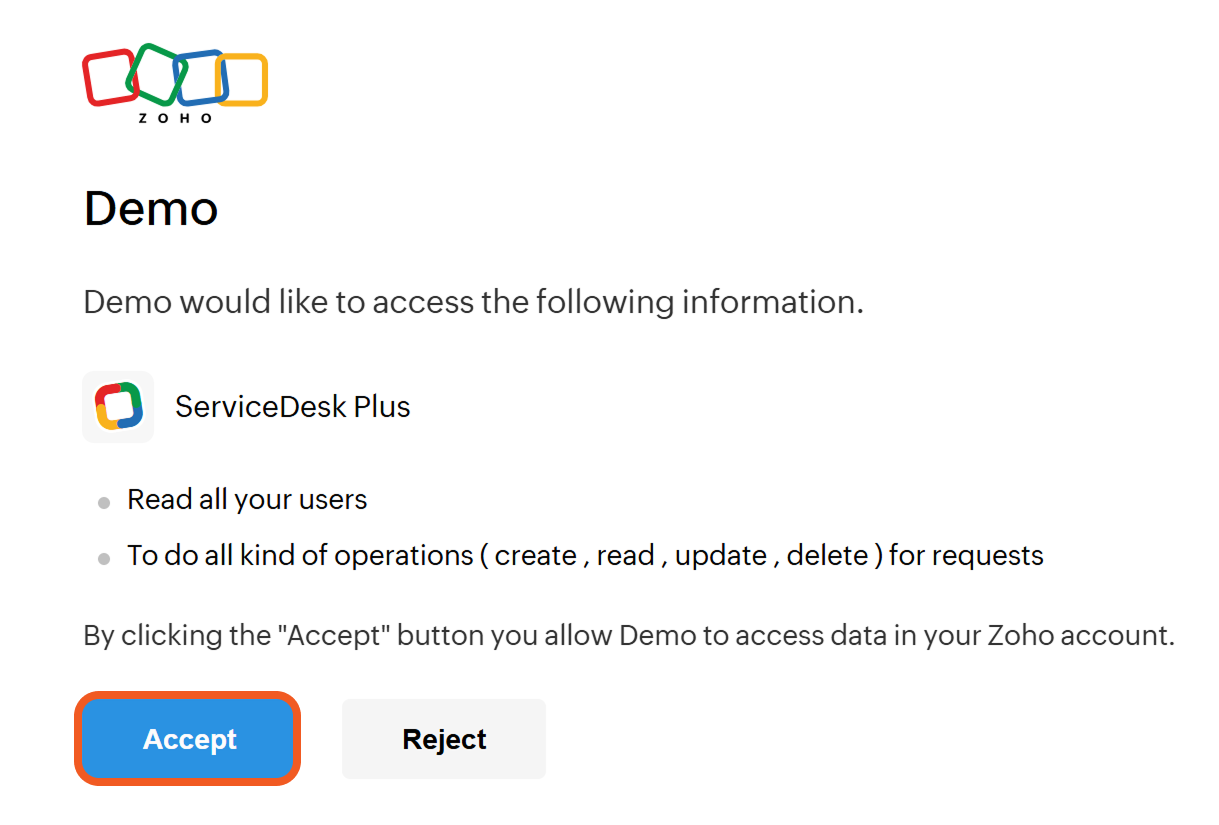
Paste the Authorization Code into the Authentication Code field.
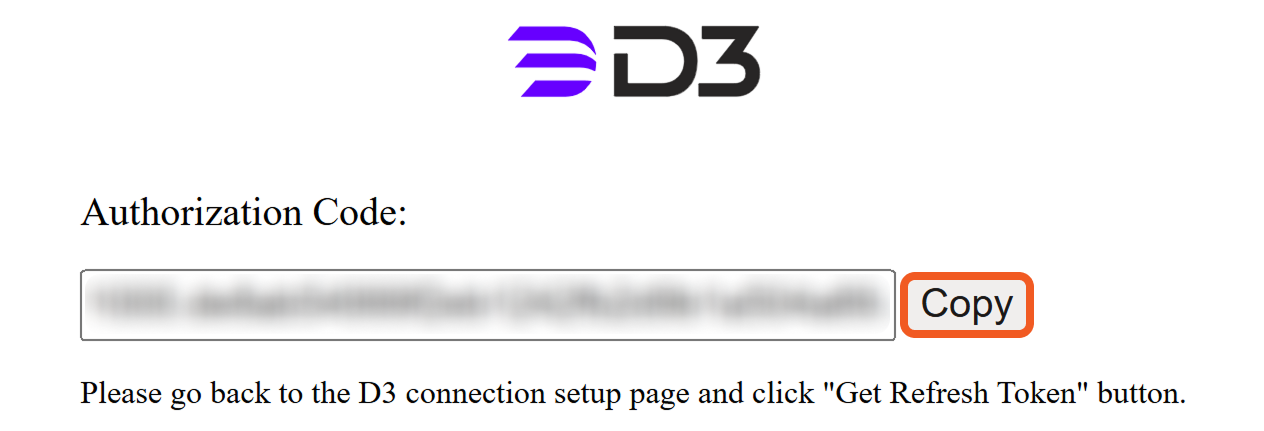
6. Input the API version. The default value is v3.
7. Click on the Get Refresh token button to automatically generate a refresh token. Refer to the Reader Note if an error occurs at this stage.
Enable Password Vault: An optional feature that allows users to take the stored credentials from their own password vault. Refer to the password vault connection guide if needed.
Connection Health Check: Periodically checks the connection status by scheduling the Test Connection command at the specified interval (in minutes). Available only for active connections, this feature also allows configuring email notifications for failed attempts.
Test the connection.
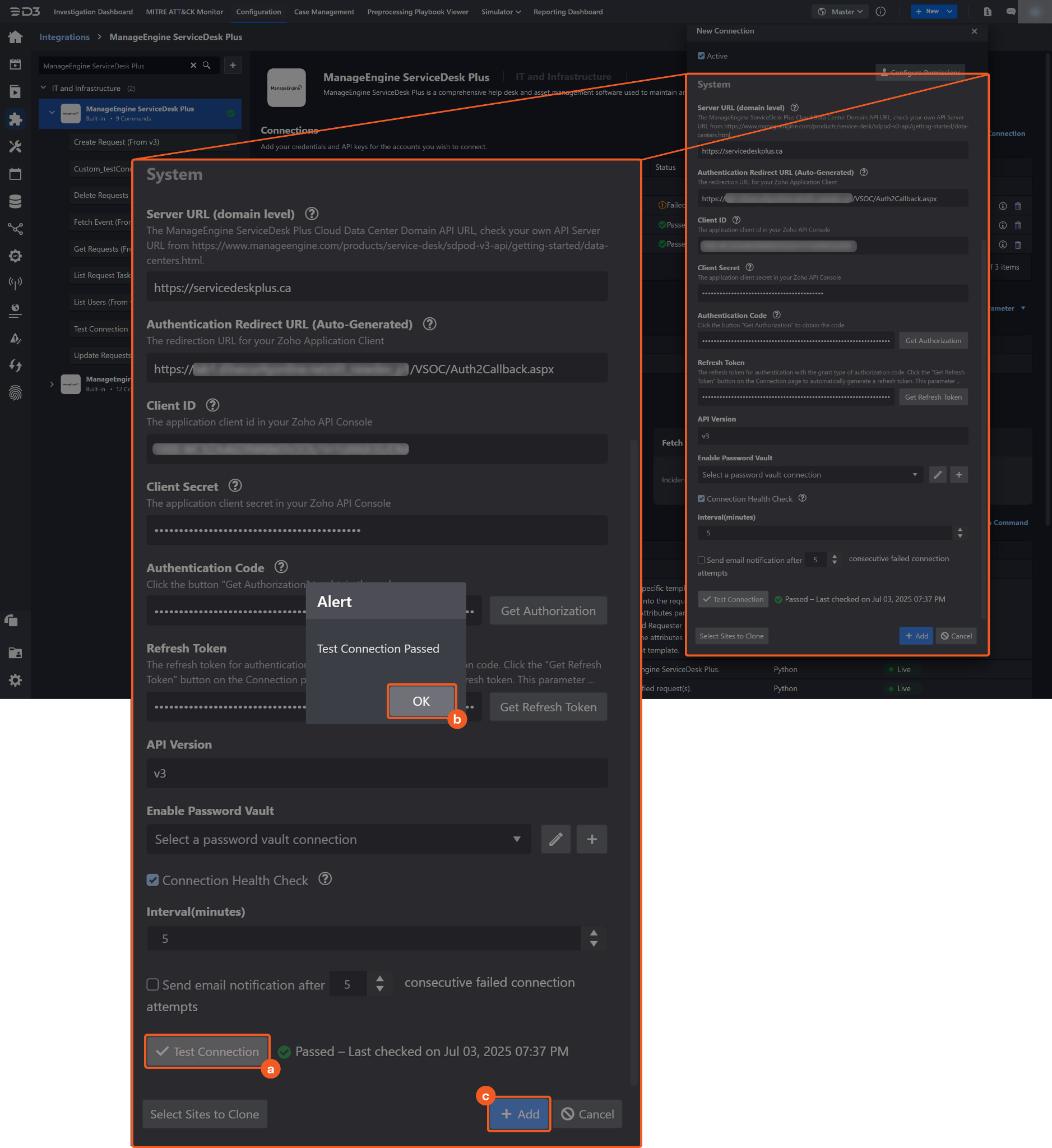
Click on the Test Connection button to verify credentials and connectivity. A success alert displays Passed with a green checkmark. If the connection fails, review the parameters and retry.
Click OK to close the alert window.
Click + Add to create and add the configured connection.
READER NOTE
If users encounter an error similar to the example below when generating a refresh token, the cause may be a mismatch between the region of the Server URL (API Domain URL) and the API Console used to generate the Client ID and Client Secret. The regions must match to generate the refresh token and pass the connection test.

Commands
ManageEngine ServiceDesk Plus includes the following executable commands for users to set up schedules or create playbook workflows. With the Test Command function, users can execute these commands independently for playbook troubleshooting.
Integration API Note
For more information about the ManageEngine ServiceDesk Plus API, refer to the ManageEngine ServiceDesk Plus API reference.
Note for Time-related parameters
The input format of time-related parameters may vary based on user account settings, which may cause the sample data in commands to differ from what is displayed. To adjust the time format, follow these steps:
Navigate to Configuration > Application Settings. Select Date/Time Format.
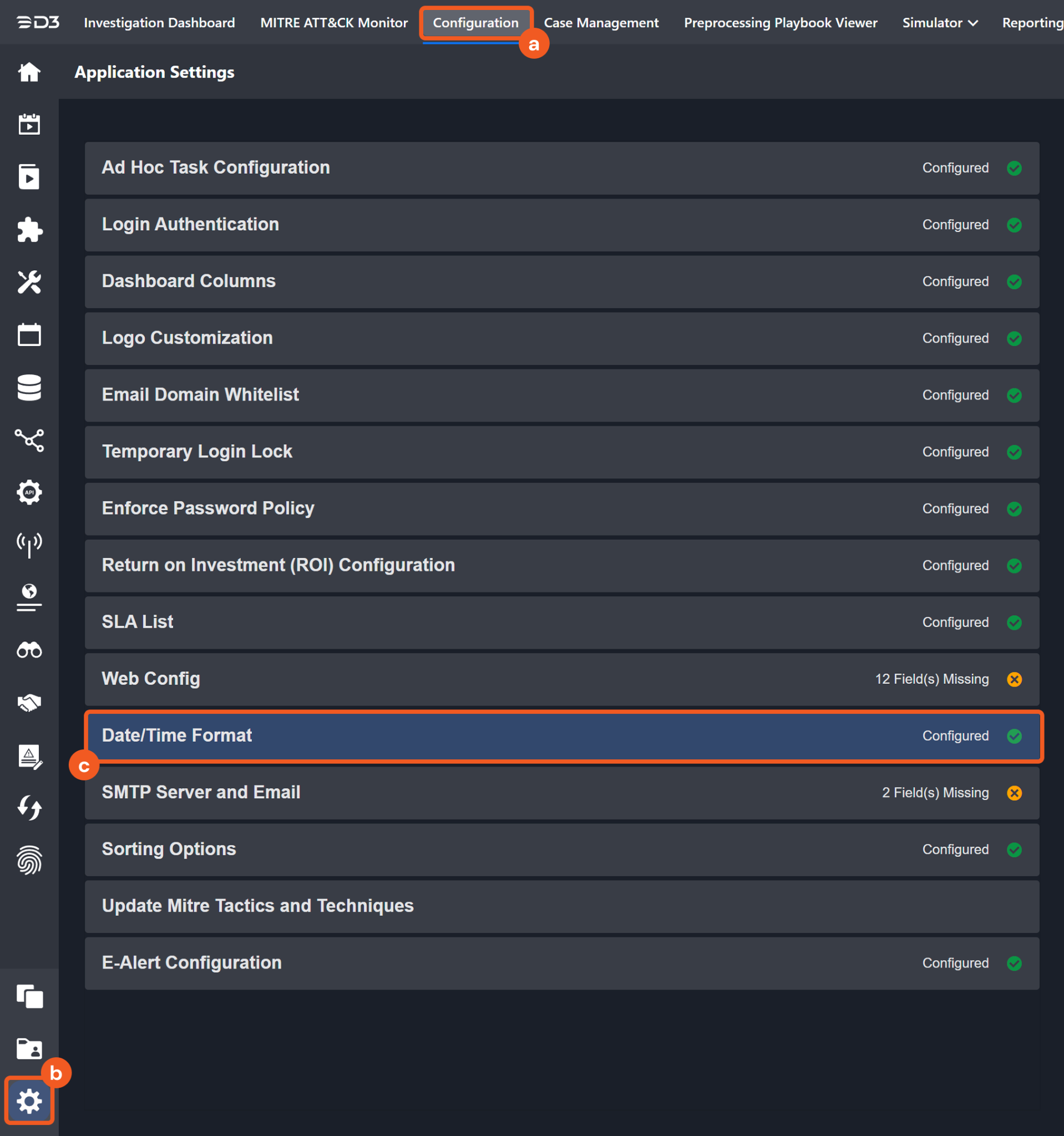
Choose the desired date and time format, then click on the Save button.

The selected time format will now be visible when configuring Date/Time command input parameters.
Create Request
Creates a new request using a specified template. Use the Additional Attributes parameter to include in the request any additional attributes. While most attributes are optional, specific templates may mandate certain attributes.
READER NOTE
Requester Email Address is a required parameter to run this command.
Run the List Users command to obtain the Requester Email Address. Requester Email Addresses can be found in the raw data at the path $.users[*].email_id.
Technician Email Address is an optional parameter to run this command.
Run the List Users command with the User Type set to Technicians to obtain the Technician Email Address. Technician Email Addresses can be found in the returned raw data at the path $.users[*].email_id.
Request Template names can be found on the ManageEngine ServiceDesk Plus UI at Setup > Incident Template.
.png?inst-v=18d3a7e1-e76a-4a76-8c99-1863ec3d3efa)
Input
Input Parameter | Required/Optional | Description | Example |
Request Template | Optional | The template used to create the request. Request Template names can be found on the ManageEngine ServiceDesk Plus UI at Setup > Incident Template. If unspecified, the default request template will be used. | Unable to browse |
Subject | Required | The request subject. The maximum length is 250 characters. | addRequest test subject |
Requester Email Address | Required | The requester's email address. Requester Email Address can be obtained using the List Users command. | *****@*****.***** |
Level | Optional | The level of the request to be created. Available options are:
| Tier 3 |
Group Name | Optional | The name of the group to which the request is assigned. | Printer Problems |
Technician Email Address | Optional | The email address of the technician assigned to the request. Technician Email Address can be obtained using the List Users command. | *****@*****.***** |
Priority | Optional | The priority level of the request. Available options are:
By default, the value is Low. This parameter is mandatory for some templates, such as SOC OPS. | Normal |
Category | Optional | The category to which the request belongs. Available options are:
| Services |
Sub Category | Optional | The sub category to which the request belongs. Available options are:
The subcategory must correspond to the selected category. | Services |
Emails to Notify | Optional | The email addresses to notify about request updates. |
JSON
|
Mode | Optional | The mode in which this request is created. Available options are:
| Phone Call |
Description | Optional | The request description in HTML format. | test desc |
Site | Optional | The site to which the request belongs. | Base Site |
Impact Details | Optional | The description about the impact of the request. The maximum length is 250 characters. | Impact scope details |
Request Type | Optional | The type of request to be created. Available options are:
| Service Request |
Status | Optional | The status of the new request. Available options are:
By default, the value is Open. | On Hold |
Additional Attributes | Optional | Additional attributes not covered by predefined fields to include in the request. Use this parameter to add User-Defined Fields (UDF). |
JSON
|
Output
To view the sample output data for all commands, refer to this article.
Error Handling
If the Return Data is Failed, an Error tab will appear in the Test Result window.
The error tab contains the details responded from D3 SOAR or third-party API calls, including Failure Indicator, Status Code, and Message. This can help locate the root cause of a command failure.
Parts in Error | Description | Example |
Failure Indicator | Indicates the command failure that happened at a specific input and/or API call. | Create Request failed. |
Status Code | The response code issued by the third-party API server or the D3 SOAR system that can be used to locate the corresponding error category. For example, if the returned status code is 401, the selected connection is unauthorized to run the command. The user or system support would need to check the permission setting in the ManageEngine ServiceDesk Plus portal. Refer to the HTTP Status Code Registry and Common Error Codes - API - User Guide for details. | ManageEngine Service Desk Plus Status Code: 4001. HTTP Status Code: 400. |
Message | The raw data or captured key error message from the integration API server about the API request failure. | Message: failed. |
Error Sample Data Create Request failed. ManageEngine Service Desk Plus Status Code: 4001. HTTP Status Code: 400. Message: failed. |
Delete Requests
Deletes specified requests from ManageEngine ServiceDesk Plus.
READER NOTE
Request IDs is a required parameter to run this command.
Run the Fetch Event command to obtain the Request IDs. Request IDs can be found in the raw data at the path $.requests[*].id.
Input
Input Parameter | Required/Optional | Description | Example |
Request IDs | Required | The IDs of the requests to delete. Request IDs can be obtained using the Fetch Event command. |
JSON
|
Output
To view the sample output data for all commands, refer to this article.
Error Handling
If the Return Data is Partially Successful or Failed, an Error tab will appear in the Test Result window.
The error tab contains the details responded from D3 SOAR or third-party API calls, including Failure Indicator, Status Code, and Message. This can help locate the root cause of a command failure.
Parts in Error | Description | Example |
Failure Indicator | Indicates the command failure that happened at a specific input and/or API call. | Delete Request failed. |
Status Code | The response code issued by the third-party API server or the D3 SOAR system that can be used to locate the corresponding error category. For example, if the returned status code is 401, the selected connection is unauthorized to run the command. The user or system support would need to check the permission setting in the ManageEngine ServiceDesk Plus portal. Refer to the HTTP Status Code Registry and Common Error Codes - API - User Guide for details. | ManageEngine Service Desk Plus Status Code: 4007. HTTP Status Code: 404. |
Message | The raw data or captured key error message from the integration API server about the API request failure. | Message: Invalid URL accessed. |
Error Sample Data Delete Request failed. ManageEngine Service Desk Plus Status Code: 4007. HTTP Status Code: 404. Message: Invalid URL accessed. |
Fetch Event
Retrieves requests as events from ManageEngine ServiceDesk Plus based on defined filters.
READER NOTE
Requester is an optional parameter to run this command.
Run List Users command to obtain the Requester Name. Requester Names can be found in the returned raw data at the path $.users[*].first_name.
Instead of using tolerance scope, it is recommended to check the Initiate the buffer time of the Data Reacquire for [x] minutes after completing the event fetch checkbox when setting up a new Data Ingestion schedule.
Navigate to Configuration > Data Ingestion, then select the Event Intake tab.
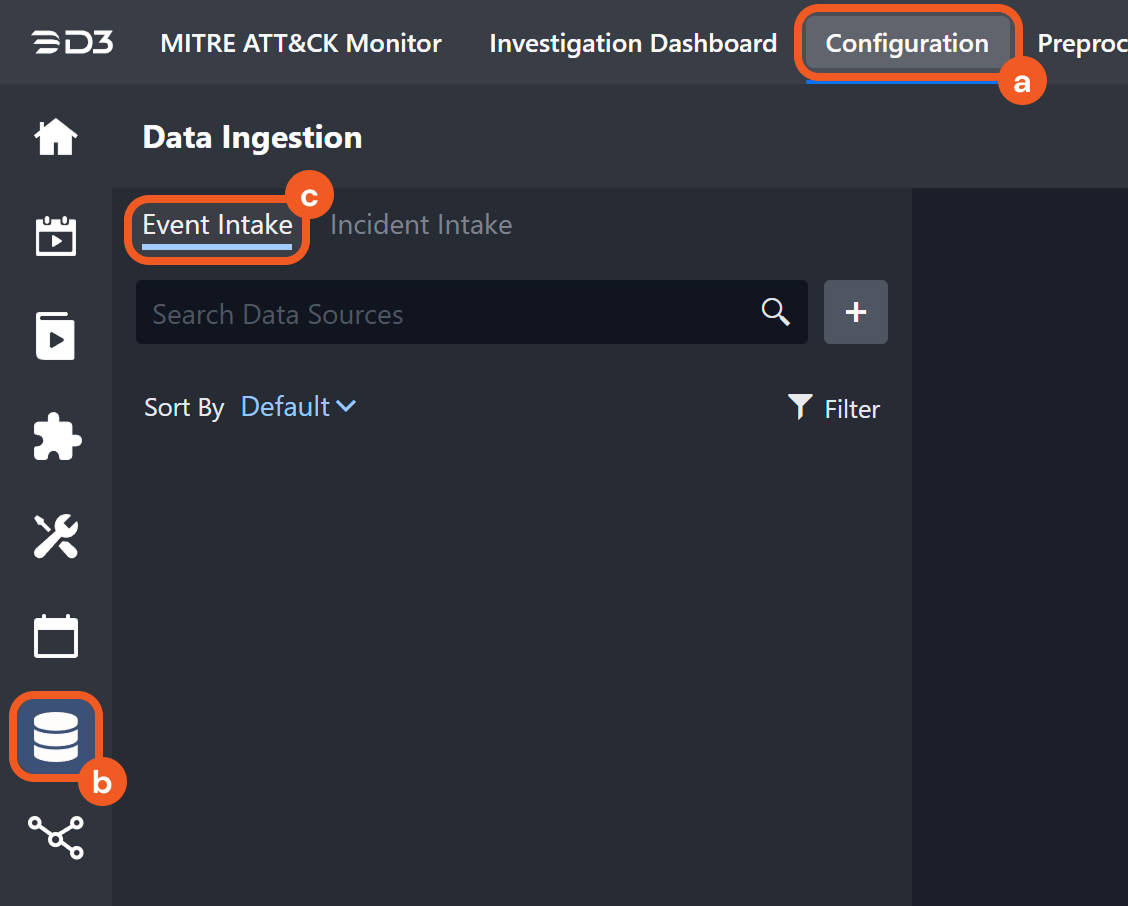
Add a New Schedule Data Source for the ManageEngine ServiceDesk Plus Integration and check the Initiate the buffer time of the Data Reacquire for [x] minutes after completing the event fetch checkbox. Optionally, adjust the buffer time as necessary.
.png?inst-v=18d3a7e1-e76a-4a76-8c99-1863ec3d3efa)
Request Template names can be found on the ManageEngine ServiceDesk Plus UI at Setup > Incident Template.
.png?inst-v=18d3a7e1-e76a-4a76-8c99-1863ec3d3efa)
Input
Input Parameter | Required/Optional | Description | Example |
Start Time | Optional | The start of the time range for retrieving requests last updated after this timestamp (in UTC). | 10/02/2020 00:00 AM |
End Time | Optional | The end of the time range for retrieving requests last updated before this timestamp (in UTC). By default, the value is the current time. | 10/02/2020 00:09 AM |
Number of Event(s) Fetched | Optional | The maximum number of requests to retrieve. Valid values range from 0 to 100. A value of 0 retrieves all matching requests. By default, the value is 10. | 100 |
Status | Optional | Filters the returned requests by status. Available options are:
By default, all requests will be returned regardless of their status. | Open |
Priority | Optional | Filters the returned requests by priority. Available options are:
By default, all requests will be returned regardless of their priority. | Low |
Request Type | Optional | Filters the returned requests by type. Available options are:
By default, all requests will be returned regardless of their request type. | Service Request |
Requester Name | Optional | Filters the returned requests by requester name. By default, all requests will be returned regardless of their requester. Requester Name can be obtained using the List Users command. | Timmy |
Template Name | Optional | Filters the returned requests by the template used to create them. Request Template names can be found on the ManageEngine ServiceDesk Plus UI at Setup > Incident Template. By default, all requests will be returned regardless of their template. | Default Request |
Impact | Optional | Filters the returned requests by impact level. Available options are:
By default, all requests will be returned regardless of their impact. | Affects Business |
Urgency | Optional | Filters the returned requests by urgency level. Available options are:
By default, all requests will be returned regardless of their urgency. | Urgent |
Tolerance Scope | Optional | A time window (in minutes) that extends the time range for fetching events by subtracting from the specified start time. Tolerance scope helps prevent data loss by accounting for API response delays caused by temporary server-side data unavailability—arising from processing and synchronization—from the vendor. With the tolerance scope applied, events will be fetched within the range of (Start Time - Tolerance Scope) to End Time. By default, the tolerance scope is set to 0. | 5 |
Output
To view the sample output data for all commands, refer to this article.
Fetch Event Field Mapping
Fetch Event commands require event field mapping. Field mapping plays a key role for data normalization within the event pipeline. Field mapping converts the original data fields from the different providers to standardized D3 fields as defined by the D3 Model. Refer to Event and Incident Intake Field Mapping for details.
To add a custom field, click on the + Add Field button. Users can also remove built-in field mappings by clicking x. Note that two underscore characters will automatically prefix the defined Field Name as the System Name for a custom field mapping. Additionally, if an input Field Name contains any spaces, they will automatically be replaced with underscores for the corresponding System Name.
As a system integration, the ManageEngine ServiceDesk Plus integration has some pre-configured field mappings for default field mapping.
Default Event Source
The Default Event Source is the default set of field mappings that are applied when this fetch event command is executed. For out-of-the-box integrations, users will find a set of field mappings provided by the system. Default event source provides field mappings for common fields from the fetched data. The default event source has a "Main Event JSON Path" (i.e. $.requests) that is used to extract a batch of events from the response raw data. View the "Main Event JSON Path" by clicking on the Edit Event Source button.

Main Event JSON Path: $.requests
The Main Event JSON Path determines the root path where the system starts parsing raw response data into D3 event data. The JSON path begins with $, representing the root element. The path is formed by appending a sequence of child elements to $, each separated by a dot (.). Square brackets with nested quotation marks ([‘...’]) should be used to separate child elements in JSON arrays.
For example, the root node of a JSON Path is $.requests. The child node denoting the Event Type field is .request_type.name. Putting it together, the JSON Path expression to extract the Event Type is $.requests.request_type.name.
The pre-configured field mappings are detailed below:
Field Name | Source Field |
Assignee | .technician.name |
Created By | .created_by.name |
Display ID | .display_id |
Due By Time | .due_by_time.display_value |
First Response Due Time | .first_response_due_by_time.display_value |
Group ID | .group.id |
Group Name | .group.name |
Impact | .impact.name |
Impact Details | .impact_details |
Item | .item.name |
On Behalf Of | .on_behalf_of.name |
Priority | .priority.name |
Project ID | .project_id |
Site ID | .site.id |
Site Name | .site.name |
Sub Category | .subcategory.name |
Template Name | .template.name |
Total Cost | .total_cost |
Update Reason | .update_reason |
Urgency | .urgency.name |
User ID | .requester.id |
Document ID | .id |
Event category | .category.name |
Event level | .level.name |
Event name | .subject |
Event Type | .request_type.name |
Start Time | .created_time.value |
Description | .description |
Status | .status.name |
Username | .requester.name |
Error Handling
If the Return Data is Failed, an Error tab will appear in the Test Result window.
The error tab contains the details responded from D3 SOAR or third-party API calls, including Failure Indicator, Status Code, and Message. This can help locate the root cause of a command failure.
Parts in Error | Description | Example |
Failure Indicator | Indicates the command failure that happened at a specific input and/or API call. | Fetch Event failed. |
Status Code | The response code issued by the third-party API server or the D3 SOAR system that can be used to locate the corresponding error category. For example, if the returned status code is 401, the selected connection is unauthorized to run the command. The user or system support would need to check the permission setting in the ManageEngine ServiceDesk Plus portal. Refer to the HTTP Status Code Registry and Common Error Codes - API - User Guide for details. | Status Code: 200. |
Message | The raw data or captured key error message from the integration API server about the API request failure. | Message: invalid_client. |
Error Sample Data Fetch Event failed. Status Code: 200. Message: invalid_client. |
Get Requests
Retrieves information on the specified requests.
READER NOTE
Request IDs is a required parameter to run this command.
Run the Fetch Event command to obtain the Request IDs. Request IDs can be found in the raw data at the path $.requests[*].id.
Input
Input Parameter | Required/Optional | Description | Example |
Request IDs | Optional | The IDs of the requests on which information will be retrieved. Request IDs can be obtained using the Fetch Event command. |
JSON
|
Output
To view the sample output data for all commands, refer to this article.
Error Handling
If the Return Data is Partially Successful or Failed, an Error tab will appear in the Test Result window.
The error tab contains the details responded from D3 SOAR or third-party API calls, including Failure Indicator, Status Code, and Message. This can help locate the root cause of a command failure.
Parts in Error | Description | Example |
Failure Indicator | Indicates the command failure that happened at a specific input and/or API call. | Get Request failed. |
Status Code | The response code issued by the third-party API server or the D3 SOAR system that can be used to locate the corresponding error category. For example, if the returned status code is 401, the selected connection is unauthorized to run the command. The user or system support would need to check the permission setting in the ManageEngine ServiceDesk Plus portal. Refer to the HTTP Status Code Registry and Common Error Codes - API - User Guide for details. | ManageEngine Service Desk Plus Status Code: 4007. HTTP Status Code: 404. |
Message | The raw data or captured key error message from the integration API server about the API request failure. | Message: Invalid URL accessed. |
Error Sample Data Get Request failed. ManageEngine Service Desk Plus Status Code: 4007. HTTP Status Code: 404. Message: Invalid URL accessed. |
List Request Tasks
Retrieves tasks associated with the specified request.
READER NOTE
Request IDs is a required parameter to run this command.
Run the Fetch Event command to obtain the Request IDs. Request IDs can be found in the raw data at the path $.requests[*].id.
Input
Input Parameter | Required/Optional | Description | Example |
Request IDs | Required | The ID of the request for which tasks will be retrieved. Request IDs can be obtained using the Fetch Event command. | 1279*****3007 |
Task Title | Optional | Filters the returned tasks by task title. | task 1 |
Actual Start Time After | Optional | Filters the returned tasks to include only those with an actual start time after the specified timestamp. | 09/06/2023 11:44 PM |
Actual Start Time Before | Optional | Filters the returned tasks to include only those with an actual start time before the specified timestamp. | 09/06/2023 11:45 PM |
Output
To view the sample output data for all commands, refer to this article.
Error Handling
If the Return Data is Failed, an Error tab will appear in the Test Result window.
The error tab contains the details responded from D3 SOAR or third-party API calls, including Failure Indicator, Status Code, and Message. This can help locate the root cause of a command failure.
Parts in Error | Description | Example |
Failure Indicator | Indicates the command failure that happened at a specific input and/or API call. | List Request Tasks failed. |
Status Code | The response code issued by the third-party API server or the D3 SOAR system that can be used to locate the corresponding error category. For example, if the returned status code is 401, the selected connection is unauthorized to run the command. The user or system support would need to check the permission setting in the ManageEngine ServiceDesk Plus portal. Refer to the HTTP Status Code Registry and Common Error Codes - API - User Guide for details. | ManageEngine Service Desk Plus Status Code: 4007. HTTP Status Code: 404. |
Message | The raw data or captured key error message from the integration API server about the API request failure. | Message: Invalid URL accessed. |
Error Sample Data List Request Tasks failed. ManageEngine Service Desk Plus Status Code: 4007. HTTP Status Code: 404. Message: Invalid URL accessed. |
List Users
Retrieves user information based on the specified user type and attributes.
Input
Input Parameter | Required/Optional | Description | Example |
User Type | Optional | Filters the returned users by type. Available options are:
By default, the value is All. | Requesters |
User Name | Optional | Filters the returned users by full or partial username. | agent-1 |
Site Name | Optional | Filters the returned users by the site to which they belong. | Base site |
Department Name | Optional | Filters the returned users by the name of the department to which they belong. | IT Services |
VIP User | Optional | Whether to only return VIP users. If False or unspecified, all users will be returned regardless of their VIP status. | True |
Output
To view the sample output data for all commands, refer to this article.
Error Handling
If the Return Data is Failed, an Error tab will appear in the Test Result window.
The error tab contains the details responded from D3 SOAR or third-party API calls, including Failure Indicator, Status Code, and Message. This can help locate the root cause of a command failure.
Parts in Error | Description | Example |
Failure Indicator | Indicates the command failure that happened at a specific input and/or API call. | List Users failed. |
Status Code | The response code issued by the third-party API server or the D3 SOAR system that can be used to locate the corresponding error category. For example, if the returned status code is 401, the selected connection is unauthorized to run the command. The user or system support would need to check the permission setting in the ManageEngine ServiceDesk Plus portal. Refer to the HTTP Status Code Registry and Common Error Codes - API - User Guide for details. | Status Code: 200. |
Message | The raw data or captured key error message from the integration API server about the API request failure. | Message: invalid_client. |
Error Sample Data List Users failed. Status Code: 200. Message: invalid_client. |
Update Requests
Updates the ticket details of the specified requests. Use the Additional Attributes parameter to include in the request any additional attributes. Deleted requests cannot be updated.
READER NOTE
Request IDs is a required parameter to run this command.
Run the Fetch Event command to obtain the Request IDs. Request IDs can be found in the raw data at the path $.requests[*].id.
Requester Email Address and Technician Email Address are optional parameters to run this command.
Run the List Users command to obtain the Requester Email Address. Requester Email Addresses can be found in the raw data at the path $.users[*].email_id.
Run the List Users command with the User Type set to Technicians to obtain the Technician Email Address. Technician Email Addresses can be found in the returned raw data at the path $.users[*].email_id.
Request Template names can be found on the ManageEngine ServiceDesk Plus UI at Setup > Incident Template.
.png?inst-v=18d3a7e1-e76a-4a76-8c99-1863ec3d3efa)
Input
Input Parameter | Required/Optional | Description | Example |
Request IDs | Required | The IDs of the requests to update. Request IDs can be obtained using the Fetch Event command. |
JSON
|
Subject | Optional | The updated subject of the request. The maximum length is 250 characters. | addRequest test subject2 |
Description | Optional | The updated description of the request in HTML format. | addRequest test description2 |
Impact Details | Optional | The updated description about the impact of the request. The maximum length is 250 characters. | Impact scope details |
Request Template | Optional | The template used to update the request. Request Template names can be found on the ManageEngine ServiceDesk Plus UI at Setup > Incident Template. | Unable to browse |
Requester Email Address | Optional | The requester's email address. Requester Email Address can be obtained using the List Users command. | *****@*****.***** |
Mode | Optional | The mode in which this request is created. Available options are:
| Phone Call |
Level | Optional | The updated level of the request. Available options are:
| Tier 3 |
Group Name | Optional | The name of the group to which the request is assigned. | Printer Problems |
Technician Email Address | Optional | The email address of the technician assigned to the request. Technician Email Address can be obtained using the List Users command. | *****@*****.***** |
Priority | Optional | The updated priority level of the request. Available options are:
This parameter is mandatory for some templates, such as SOC OPS. | Normal |
Category | Optional | The category to which the request belongs. Available options are:
| Services |
Sub Category | Optional | The sub category to which the request belongs. Available options are:
The subcategory must correspond to the selected category. | Services |
Emails to Notify | Optional | The email addresses to notify about request updates. |
JSON
|
Site | Optional | The site to which this request belongs. | Base Site |
Request Type | Optional | The type of request to be updated. Available options are:
| Service Request |
Status | Optional | The updated status of the request. Available options are:
| Resolved |
Additional Attributes | Optional | Additional attributes not covered by predefined fields to include in the request. Use this parameter to add User-Defined Fields (UDF). |
JSON
|
Output
To view the sample output data for all commands, refer to this article.
Error Handling
If the Return Data is Partially Successful or Failed, an Error tab will appear in the Test Result window.
The error tab contains the details responded from D3 SOAR or third-party API calls, including Failure Indicator, Status Code, and Message. This can help locate the root cause of a command failure.
Parts in Error | Description | Example |
Failure Indicator | Indicates the command failure that happened at a specific input and/or API call. | Update Request failed. |
Status Code | The response code issued by the third-party API server or the D3 SOAR system that can be used to locate the corresponding error category. For example, if the returned status code is 401, the selected connection is unauthorized to run the command. The user or system support would need to check the permission setting in the ManageEngine ServiceDesk Plus portal. Refer to the HTTP Status Code Registry and Common Error Codes - API - User Guide for details. | ManageEngine Service Desk Plus Status Code: 4001. HTTP Status Code: 400. |
Message | The raw data or captured key error message from the integration API server about the API request failure. | Message: failed. |
Error Sample Data Update Request failed. ManageEngine Service Desk Plus Status Code: 4001. HTTP Status Code: 400. Message: failed. |
Test Connection
Allows users to perform a health check on an integration connection. Users can schedule a periodic health check by selecting Connection Health Check when editing an integration connection.
Input
N/A
Output
Output Type | Description | Return Data Type |
Return Data | Indicates one of the possible command execution states: Successful or Failed. The Failed state can be triggered by any of the following errors:
More details about an error can be viewed in the Error tab. | String |
Error Handling
If the Return Data displays Failed, an Error tab will appear in the Test Result window.
The error tab contains the details responded from D3 SOAR or third-party API calls, including Failure Indicator, Status Code, and Message. This can help locate the root cause of a command failure.
Parts in Error | Description | Example |
Failure Indicator | Indicates the command failure that happened at a specific input and/or API call. | Test Connection failed. Failed to check the connector. |
Status Code | The response code issued by the third-party API server or the D3 SOAR system that can be used to locate the corresponding error category. For example, if the returned status code is 401, the selected connection is unauthorized to run the command. The user or system support would need to check the permission setting in the ManageEngine ServiceDesk Plus portal. Refer to the HTTP Status Code Registry for details. | Status Code: 200. |
Message | The raw data or captured key error message from the integration API server about the API request failure. | Message: invalid_client. |
Error Sample Data Test Connection failed. Failed to check the connector. Status Code: 200. Message: invalid_client. |
